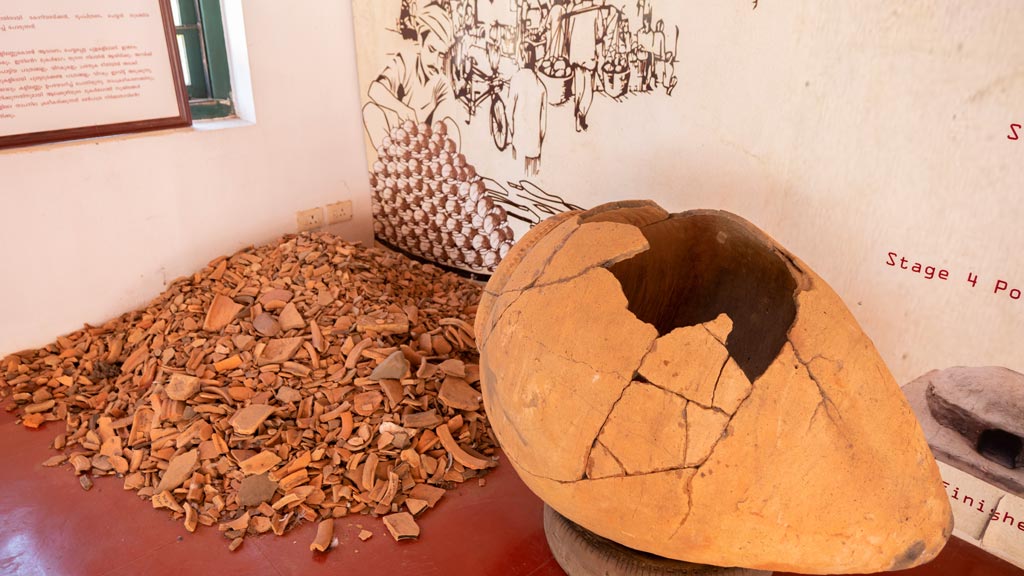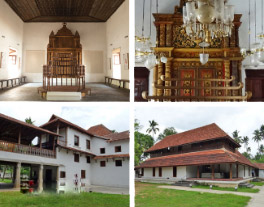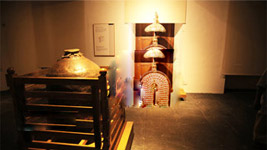Excavations

The two main excavation sites that provided invaluable evidences for the port of Muziris were Kottappuram and Pattanam. Read more about the significance of the regions and the artefacts unearthed.
Kottappuram Fort
At the first glance, the Kottappuram Fort may not look very impressive to the modern eye. Located right at the mouth of the Periyar, it appears to be nothing more than a set of dilapidated thick walls, overrun by creepers and inscribed over with graffiti. But there was a time when the structure was truly formidable, held promise of great power and prestige, and was the bone of contention among many powers, native and foreign. Built in 1523 by the Portuguese, it stands to the north of Pallippuram Fort. It had bastions fitted with guns, housed military barracks, bungalows and also places of worship. In 1662, the fort was witness to a struggle for control between the Zamorin [ruler of Calicut] and the Dutch. The next year the Portuguese withdrew their claim on the fort. Eventually the Dutch seized control of this fort but they set out to destroy the existing structure and build another on the same site. By 1670 the new one was completed. Later, Marthanada Varma who ruled the princely state of Travancore from 1729 till his death in 1758, bought this fort from the Dutch. However, in 1790, in the course of an invasion by the ruler of the kingdom of Mysore, Tipu Sultan, the fort was conquered and destroyed. In the end, when the British defeated Tipu Sultan, Travancore got the fort back. But by then, all the buildings were in ruins. The fort was reduced to a few walls here and there, with a few run-down bastions in between. It lay thus in a state of ruin until the Muziris Heritage Project took it under their wing.
The process of excavation began with clearing the entire fortification area. Certain structural remains were found in the process. Two walls, one at the northern end and other at the centre of the fortification area, were identified along with two bastions and an arched cellar. Quadrants were used with the intention of tracing out submerged structural remains and levelling the entire fortification area as well. Further excavation in the trenches mainly revealed a few flights of steps, a massive laterite wall, mud rammed floor, etc. Major artefacts that were unearthed included coins, door hinges, clamps, cannon balls made of stone and iron, different types of nails, etc. Roof tiles, bricks with non-indigenous character and square-shaped floor tiles were also uncovered during the excavation.
The excavated fort at Kottappuram is soon expected to turn into a happening site museum.
Pattanam Excavation
Pattanam was a modest, quiet and nondescript town in Ernakulam district until recently. However, it became what the renowned historian Romila Thapar described as "a turning point for studies into India’s maritime relations" when excavations in the area unearthed evidences of an advanced civilization in a bygone era. As the assorted pieces of a gigantic historical jigsaw puzzle began to form a recognizable pattern, historians were able to reconstruct the story of a land that had long-time and deep connections with peoples and cultures from far-flung areas of the globe, as far back in time as 2,000 years back.
The Pattanam excavation is the first ever multi-disciplinary excavation to be undertaken in Kerala. The excavation is aimed at unearthing archaeological evidence, which will help to locate/identify an early historic urban settlement and the ancient Indo-Roman port of Muziris or Musiri on the Malabar coast.
The site at Pattanam extends to approximately 1.5 sq. kms and the core area measures about 600 x 400 m. The north-eastern part of the site was chosen for excavation based on the surface exploration undertaken earlier. The ‘locus methodology’ adopted for this excavation helped distinguish each layer/feature/pit/structure/activity area on the basis of colour, texture and composition.
Many important finds were obtained like human bones, storage jars, a gold ornament, glass beads, stone beads, utility objects made of stone, copper and iron, typical pottery, early Chera coins, brick wall, brick platform, ring well, wharf with bollards and a six-meter long wooden canoe parallel to the wharf structure about 2.5 m below the surface.
The structures indicate a vast ‘urban’ settlement. The excavations suggest that the site was first occupied by the indigenous Megalithic (Iron Age) people, followed by the Roman contact in the early historic period. It appears that the site was continually occupied from 2nd century BCE to 10th century CE. The maritime contacts of this region during the early historic period seem to have been extensive as evidenced by a large number of Roman amphora shreds, a few terra sigillata shreds, Sassanian Yemenite and other West Asian potteries. The sheer number of roulette ware probably made in the Bengal-Gangetic region signifies the site’s importance in the pan Indian context as well.

